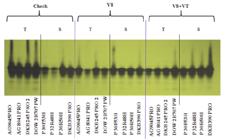ABSTRACT.
This study was carried out with the objective of evaluating the effect of fungicide application on grain rot in commercial maize hybrids and the relation between grain rot and the expression of lipoxygenase enzyme in grain in conventional row spacing of 0.70 m and reduced row spacing of 0.45 m. Treatments were made in a 3 x 8 factorial scheme, using three forms of management with fungicide (Trifloxystrobin + Prothioconazole) and eight maize hybrids divided into two groups (tolerant and susceptible) with three repetitions, totaling 72 plots in each environment (conventional and reduced spacing) in the 2013/2014 crop. The following characteristics were evaluated: grain rot percentage and lipoxygenase enzyme expression (LOX) in the grain. The hybrid and the fungicide utilized influenced the grain rot percentage. Grain rot percentage was reduced by the use of the fungicide, and the highest reduction was in susceptible hybrids with two applications, V8 and V8+VT. There was higher expression of LOX enzyme in maize hybrids that belong to the group tolerant of fungi that cause grain rot .The use of the fungicide in two applications, V8 (eight leaves) and VT (tasseling), increased the intensity of the LOX enzyme, which was more evident for the reduced spacing.
Keywords:
LOX; spindle rot; chemical control; reduced spacing; Zea mays

 Thumbnail
Thumbnail
 Thumbnail
Thumbnail
 Thumbnail
Thumbnail


